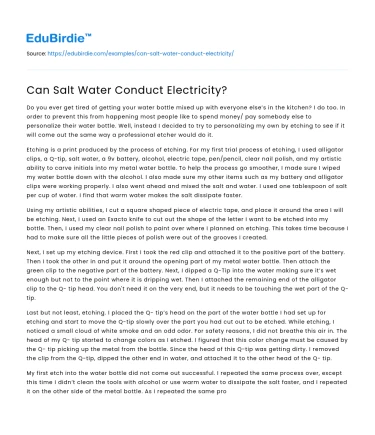Introduction
Electricity is a fundamental aspect of modern life, powering everything from household lighting to industrial machinery. One intriguing question in the realm of physical sciences is whether salt water can conduct electricity. This inquiry is not merely an academic exercise; it has practical implications in fields such as environmental science, electrical engineering, and maritime operations. Salt water is a polar solvent, which means it can dissolve ionic compounds, leading to the formation of charged particles called ions. The presence of these ions is crucial in determining the electrical conductivity of a solution. This essay explores the mechanisms by which salt water conducts electricity, the factors affecting its conductivity, and the practical applications and implications of these phenomena. By examining both theoretical principles and real-world applications, we can gain a comprehensive understanding of this fascinating aspect of chemistry and physics.
Mechanisms of Conductivity in Salt Water
At the heart of salt water's ability to conduct electricity is the process of ionization. When salt (sodium chloride, NaCl) is dissolved in water, it dissociates into sodium (Na+) and chloride (Cl-) ions. These ions are charged particles that are free to move within the solution, facilitating the flow of electric current. According to Faraday's laws of electrolysis, the movement of ions under the influence of an electric field constitutes a current. Thus, the presence of free-moving ions in salt water enables it to conduct electricity effectively.
Save your time!
We can take care of your essay
- Proper editing and formatting
- Free revision, title page, and bibliography
- Flexible prices and money-back guarantee
The degree to which salt water can conduct electricity is influenced by several factors, including the concentration of the salt, the temperature of the solution, and the presence of other dissolved substances. Higher salt concentrations increase the number of ions in the solution, enhancing conductivity. Similarly, higher temperatures can increase the kinetic energy of the ions, further facilitating their movement and thus increasing conductivity. However, the presence of other ions or molecules that interact with the sodium or chloride ions can alter the solution's overall conductivity, either enhancing or inhibiting the flow of electricity.
Real-world experiments have demonstrated these principles. For instance, a study published in the Journal of Chemical Education showed that increasing the salt concentration in water led to a measurable increase in the solution's electrical conductivity. This supports the theoretical framework that emphasizes the role of ion concentration in conductivity. By understanding these mechanisms, scientists and engineers can manipulate the conditions to optimize conductivity for various applications.
Factors Influencing Conductivity
Several factors can influence the electrical conductivity of salt water, and understanding these can aid in optimizing its use in practical applications. One key factor is the type of salt dissolved in the water. While sodium chloride is the most common, other salts such as magnesium chloride or potassium sulfate can also be dissolved, each imparting different conductivity characteristics due to the differing mobility and charge of the ions involved.
Temperature is another critical factor. As temperature increases, the mobility of ions typically increases, leading to higher conductivity. This relationship is particularly relevant in natural settings, such as oceans, where temperature gradients can affect the conductivity of seawater. According to a study in the journal Marine Chemistry, variations in ocean temperature can significantly impact the electrical properties of seawater, which is essential for applications like underwater communication and navigation systems.
Moreover, the presence of impurities or additional substances in the water can affect conductivity. For instance, pollutants or organic matter can interact with the ions, potentially forming complexes that reduce the number of free ions available to carry an electric current. This interplay between purity and conductivity is an important consideration in industrial processes where precise control of electrical properties is required.
Applications and Implications
The ability of salt water to conduct electricity is not just a scientific curiosity; it has profound practical implications. In the field of environmental monitoring, measuring the electrical conductivity of water bodies can provide insights into salinity levels, which are crucial for understanding ecosystem health. Engineers also exploit the conductive properties of salt water in designing systems for desalination, where electric fields are used to separate salt from water in processes like electrodialysis.
Furthermore, the conductivity of salt water is a critical factor in marine navigation and communication. Submarine cables that transmit data across continents rely on the conductive properties of seawater to function effectively. According to the International Journal of Electrical Power & Energy Systems, understanding the conductivity of seawater is essential for optimizing the performance of these communication systems.
Despite these benefits, there are challenges and limitations associated with the conductivity of salt water. For instance, the corrosive nature of salt water due to its ionic content can pose risks to marine infrastructure. Engineers must carefully select materials that can withstand corrosion while maintaining the necessary conductive properties for their applications.
Conclusion
In conclusion, the ability of salt water to conduct electricity is a complex phenomenon governed by the presence of ions and influenced by factors such as concentration, temperature, and impurities. This property has significant implications across various fields, from environmental science to engineering. While salt water's conductivity enables numerous technological advancements, it also presents challenges, particularly in terms of material durability and environmental impact. Future research may focus on developing innovative solutions to mitigate these challenges, ensuring that the conductive properties of salt water can be harnessed effectively and sustainably. Understanding the interplay between the theoretical aspects and practical applications of salt water conductivity is essential for advancing both scientific knowledge and technological development.






 Stuck on your essay?
Stuck on your essay?

